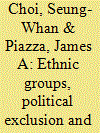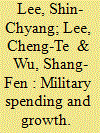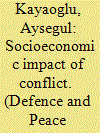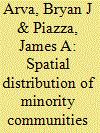|
|
|
Sort Order |
|
|
|
Items / Page
|
|
|
|
|
|
|
| Srl | Item |
| 1 |
ID:
143599


|
|
|
|
|
| Summary/Abstract |
This study examines whether the exclusion of ethnic groups from political power is an important contributing factor to domestic terrorism. To empirically test this question, we employ a negative binomial regression estimation on 130 countries during the period from 1981 to 2005. We find that countries in which certain ethnic populations are excluded from political power are significantly more likely to experience domestic terrorist attacks and to suffer from terrorist casualties; furthermore, ethnic group political exclusion is a more consistent and substantive predictor of domestic terrorist activity than general political repression or economic discrimination.
|
|
|
|
|
|
|
|
|
|
|
|
|
|
|
|
| 2 |
ID:
143600


|
|
|
|
|
| Summary/Abstract |
This paper analyzes time-sensitive data on a humanitarian crisis in the Middle East. It aims to assess the impact of the steep influx of Syrian refugees into Jordan on the country’s labor market since the onset of the conflict in Syria (March 2011). As of August 2014, nearly three million registered Syrians have sought refuge in neighboring countries (Lebanon, Jordan, Iraq, and Turkey), according to the United Nations High Commissioner for Refugees. Jordan and Lebanon are hosting the majority of them. This paper utilizes data regarding unemployment rates, employment rates, labor force participation, the number of refugees, and economic activity at the level of governorates. The vector autoregressive methodology is used to examine time series data from the most affected governorates in Jordan. The empirical results of Granger causality tests and impulse response functions show that there is no relationship between the influx of Syrian refugees and the Jordanian labor market. Our results are verified through a set of robustness checks.
|
|
|
|
|
|
|
|
|
|
|
|
|
|
|
|
| 3 |
ID:
143604


|
|
|
|
|
| Summary/Abstract |
Increases in military spending have a big impact on the socioeconomic conditions in any country. However, there is no consensus as to whether the rising military expenditure is beneficial or detrimental to economic growth. The present study chose China as a case study to empirically examine a complex relationship between military expenditure and economic development. The findings from the Johansen cointegration test indicated that there existed a long-run relationship between China’s military spending and economic growth. Furthermore, the Granger causality test detected a unidirectional causality from economic development to military expenditure. These results were further confirmed by the findings from the impulse response function. This means that China represents an example of a developing economy where the size of military expenditure expands in the process of economic transformation.
|
|
|
|
|
|
|
|
|
|
|
|
|
|
|
|
| 4 |
ID:
143601


|
|
|
|
|
| Summary/Abstract |
The relationship between economic growth and military expenditure has been the subject of a large literature in defence economics. This study analyses the influence of military expenditures on economic growth in a global perspective for the time period 2000–2010 taking spatial dimension into account. The augmented Solow model is employed to investigate the defence-growth nexus using the cross-sectional data relating to 128 countries. Following a traditional regression analysis, spatial variations in the relationships are examined utilizing different spatial econometric specifications estimated by maximum likelihood. The regressions are compared with each other via likelihood ratio tests, and the spatial Durbin model is found to be the most appropriate one suggesting that the typical least-squares model is misspecified. Empirical evidence indicates that military expenditure has a positive effect on economic growth with a significant spatial dependence for the time period under consideration.
|
|
|
|
|
|
|
|
|
|
|
|
|
|
|
|
| 5 |
ID:
143602


|
|
|
|
|
| Summary/Abstract |
The paper analyzes the effects of military spending on economic growth in a small open stochastic endogenous growth model involving the supply-side and demand-side effects produced by military spending. We show that a rise in the military spending affects economic growth through four channels, including the crowding-out effect, the spin-off effect, the resource mobilization effect, and the portfolio effect. The net effect which depends on these four channels is ambiguous. Hence, we demonstrate that there exists an optimal defense burden that maximizes the economic growth rate.
|
|
|
|
|
|
|
|
|
|
|
|
|
|
|
|
| 6 |
ID:
143603


|
|
|
|
|
| Summary/Abstract |
Uprising tensions during 2010 in eastern and southeastern regions of Turkey provoked arguments about the necessity for a State of Emergency (SOE; ‘Olağanüstü Hal’ in Turkish) declaration in those regions, with a belief of enduring political sustainability. The discussion is inflamed by a speech of the Nationalist Movement Party’s leader about the suggestion to announce a SOE ruling after the death of 24 Turkish soldiers in Hakkari (a city in the southeast of Turkey) in an attack of the PKK (Kurdistan Workers’ Party) on the 19 October 2011. Although a new announcement of SOE did not take place, the discussion itself induced the idea behind this paper which is to provide a quantitative analysis of the SOE in Turkey. In fact, the SOE ruling is not a new concept for Turkey and it has been implemented in 13 cities in the eastern and southeastern regions from 1987 to 2002. Although there have been many discussions about the costs of these 15 years of the SOE ruling in terms of military expenditure and, thus, on the national budget, there is a lack of quantitative analytical examination of the economic and social costs of it. Difference-in-differences analysis reveals negative spillover impacts of the SOE, especially on the forced migration, unemployment, and educational investments. The results also show that SOE ruling is an important factor for the underdevelopment of the eastern and southeastern regions in Turkey and, thus, a new SOE will bring enormous inequalities, both economically and socially, and an intensification of the ethnic tensions in Turkey.
|
|
|
|
|
|
|
|
|
|
|
|
|
|
|
|
| 7 |
ID:
143598


|
|
|
|
|
| Summary/Abstract |
Qualitative studies of terrorist movements frequently highlight the importance of diaspora communities as important factors in producing and sustaining terrorist activity in countries. The underlying theoretical argument is that bifurcation of tight-knit minority communities between countries nurtures separatist or irredentist sentiments among affected community members, thus prompting terrorist activity, while minority community members in other countries might mobilize financial and political resources to support terrorist activity among their compatriots. In this study, we empirically test whether transnational dispersion, versus domestic concentration, of minority communities in countries produces higher incidents of terrorism. Conducting a series of negative binomial estimations on a reshaped database of around 170 countries from 1981 to 2006, derived from the Minorities at Risk database and the Global Terrorism Database, we determine that both transnational dispersion of kin minority communities and domestic concentration of minorities within countries increase terrorism and that transnational dispersion is a particularly robust predictor of terrorist attacks.
|
|
|
|
|
|
|
|
|
|
|
|
|
|
|
|
|
|
|
|
|